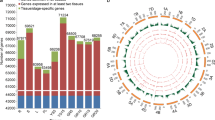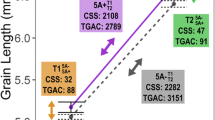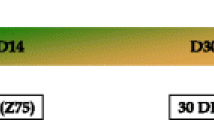Abstract
Bread wheat (Triticum aestivum L.) is an allohexaploid, and the transcriptional characteristics of the wheat embryo and endosperm during grain development remain unclear. To analyze the transcriptome, we performed isoform sequencing (Iso-Seq) for wheat grain and RNA sequencing (RNA-Seq) for the embryo and de-embryonated kernels. The differential regulation between the embryo and de-embryonated kernels was found to be greater than the difference between the two time points for each tissue. Exactly 2264 and 4790 tissue-specific genes were found at 14 days post-anthesis (DPA), while 5166 and 3784 genes were found at 25 DPA in the embryo and de-embryonated kernels, respectively. Genes expressed in the embryo were more likely to be related to nucleic acid and enzyme regulation. In de-embryonated kernels, genes were rich in substance metabolism and enzyme activity functions. Moreover, 4351, 4641, 4516, and 4453 genes with the A, B, and D homoeoloci were detected for each of the four tissues. Expression characteristics suggested that the D genome may be the largest contributor to the transcriptome in developing grain. Among these, 48, 66, and 38 silenced genes emerged in the A, B, and D genomes, respectively. Gene ontology analysis showed that silenced genes could be inclined to different functions in different genomes. Our study provided specific gene pools of the embryo and de-embryonated kernels and a homoeolog expression bias model on a large scale. This is helpful for providing new insights into the molecular physiology of wheat.








Similar content being viewed by others
References
Algan G, Bakar HN (1996) Light and electron microscopic examination of the embryo and endosperm development in the natural tetraploid Trifolium pratense L. Israel J Plant Sci 44:273–288. https://doi.org/10.1080/07929978.1996.10676651
Avni R, Nave M, Barad O, Baruch K, Twardziok SO, Gundlach H, Hale I, Mascher M, Spannagl M, Wiebe K, Jordan KW, Golan G, Deek J, Ben-Zvi B, Ben-Zvi G, Himmelbach A, MacLachlan RP, Sharpe AG, Fritz A, Ben-David R, Budak H, Fahima T, Korol A, Faris JD, Hernandez A, Mikel MA, Levy AA, Steffenson B, Maccaferri M, Tuberosa R, Cattivelli L, Faccioli P, Ceriotti A, Kashkush K, Pourkheirandish M, Komatsuda T, Eilam T, Sela H, Sharon A, Ohad N, Chamovitz DA, Mayer KFX, Stein N, Ronen G, Peleg Z, Pozniak CJ, Akhunov ED, Distelfeld A (2017) Wild emmer genome architecture and diversity elucidate wheat evolution and domestication. Science 357:93–97. https://doi.org/10.1126/science.aan0032
Bethke PC, Schuurink R, Jones RL (1997) Hormonal signalling in cereal aleurone. J Exp Bot 48:1337–1356. https://doi.org/10.1093/jxb/48.7.1337
Bottley A, Koebner RMD (2008) Variation for homoeologous gene silencing in hexaploid wheat. Plant J, 56: 297–302. doi:18564382
Bottley A, Xia GM, Koebner RMD (2006) Homoeologous gene silencing in hexaploid wheat. Plant J 47:897–906. https://doi.org/10.1111/j.1365-313X.2006.02841.x
Bottley A, Chapman NH, Koebner RMD. (2008) Homoeologous gene silencing in tissue cultured wheat callus. BMC Genet, 9: 65. doi:18928533
Brinton J, Simmonds J, Uauy C (2018) Ubiquitin-related genes are differentially expressed in isogenic lines contrasting for pericarp cell size and grain weight in hexaploid wheat. BMC Plant Biol, 18: 22. doi:29370763
Cao H, He M, Zhu C, Yuan L, Dong L, Bian Y, Zhang W, Yan Y (2016) Distinct metabolic changes between wheat embryo and endosperm during grain development revealed by 2D-DIGE-based integrative proteome analysis. Proteomics, 16: 1515–1536. doi:26968330
Deng W, Wang Y, Liu Z, Cheng H, Xue Y (2014) HemI: a toolkit for illustrating heatmaps. PLoS One 9:e111988. https://doi.org/10.1371/journal.pone.0111988
Drisch RC, Stahl Y (2015) Function and regulation of transcription factors involved in root apical meristem and stem cell maintenance. Front Plant Sci, 6: 505. doi:https://doi.org/10.3389/fpls.2015.00505
Dubrovina AS, Kiselev KV, Zhuravlev YN (2013) The role of canonical and noncanonical pre-mRNA splicing in plant stress responses. Biomed Res Int, 2013: 264314–264314. doi:https://doi.org/10.1155/2013/264314, 14
Fábián A, Jäger K, Rakszegi M, Barnabás B (2011) Embryo and endosperm development in wheat (Triticum aestivum L.) kernels subjected to drought stress. Plant Cell Rep, 30: 551–563. doi:21246199
Feldman M, Levy AA (2012) Genome evolution due to allopolyploidization in wheat. Genetics 192:763–774. https://doi.org/10.1534/genetics.112.146316
Gao F, Wen W, Liu J, Rasheed A, Yin G, Xia X, Wu X, He Z (2015) Genome-wide linkage mapping of QTL for yield components, plant height and yield-related physiological traits in the chinese wheat cross Zhou 8425B/Chinese Spring. Front Plant Sci, 6: 1099. doi:https://doi.org/10.3389/fpls.2015.01099
Gao Z, Liang XG, Zhang L, Lin S, Zhao X, Zhou LL, Shen S, Zhou SL (2017) Spraying exogenous 6-benzyladenine and brassinolide at maize yield by enhancing source and sink capacity tasseling increases. Field Crop Res 211:1–9. https://doi.org/10.1016/j.fcr.2017.05.027
Guo G, Lv D, Yan X, Subburaj S, Ge P, Li X, Hu Y, Yan Y (2012) Proteome characterization of developing grains in bread wheat cultivars (Triticum aestivum L.). BMC Plant Biol, 12: 147. doi:22900893
Han R, Jian C, Lv J, Yan Y, Chi Q, Li Z, Wang Q, Zhang J, Liu X, Zhao H (2014) Identification and characterization of microRNAs in the flag leaf and developing seed of wheat (Triticum aestivum L.). BMC Genomics 15:289. https://doi.org/10.1186/1471-2164-15-289
Han C, Zhen S, Zhu G, Bian Y, Yan Y (2017) Comparative metabolome analysis of wheat embryo and endosperm reveals the dynamic changes of metabolites during seed germination. Plant Physiol Biochem, 115: 320–327. doi:28415032
He M, Zhu C, Dong K, Zhang T, Cheng Z, Li J, Yan Y (2015) Comparative proteome analysis of embryo and endosperm reveals central differential expression proteins involved in wheat seed germination. BMC Plant Biol 15:97. https://doi.org/10.1186/s12870-015-0471-z
Huang S, Chen X, Zhong X, Li M, Ao K, Huang J, Li X (2016) Plant TRAF proteins regulate NLR immune receptor turnover. Cell Host Microbe 19(2):204–215
Kang GZ, Xu W, Liu GQ, Peng XQ, Guo TC (2013) Comprehensive analysis of the transcription of starch synthesis genes and the transcription factor RSR1 in wheat (Triticum aestivum) endosperm. Genome 56:115–122
Kiyosue et al (1999) Control of fertilization-independent endosperm development by the MEDEA polycomb gene in Arabidopsis. P Natl Acad Sci USA 96:4186–4191. https://doi.org/10.1073/pnas.96.7.4186
Kohler C, Hennig L, Bouveret R, Gheyselinck J, Grossniklaus U, Gruissem W (2003) Arabidopsis MSI1 is a component of the MEA/FIE Polycomb group complex and required for seed development. EMBO J 22:4804–4814. https://doi.org/10.1093/emboj/cdg444
Kong L, Guo H, Sun M (2015) Signal transduction during wheat grain development. Planta 241:789–801. https://doi.org/10.1007/s00425-015-2260-1
Leach LJ, Belfield EJ, Jiang C, Brown C, Mithani A, Harberd NP (2014) Patterns of homoeologous gene expression shown by RNA sequencing in hexaploid bread wheat. BMC Genomics 15:276
Lee KP, Piskurewicz U, Turecková V, Strnad M, Lopez-Molina L (2010) A seed coat bedding assay shows that RGL2-dependent release of abscisic acid by the endosperm controls embryo growth in Arabidopsis dormant seeds. P Natl Acad Sci USA 107:19108–19113
Li P, Ponnala L, Gandotra N, Wang L, Si Y, Tausta SL, Kebrom TH, Provart N, Patel R, Myers CR, Reidel EJ, Turgeon R, Liu P, Sun Q, Nelson T, Brutnell TP (2010) The developmental dynamics of the maize leaf transcriptome. Nat Genet 42:1060–1067
Li A, Liu D, Wu J, Zhao X, Hao M, Geng S, Yan J, Jiang X, Zhang L, Wu J, Yin L, Zhang R, Wu L, Zheng Y, Mao L (2014) mRNA and small RNA transcriptomes reveal insights into dynamic homoeolog regulation of allopolyploid heterosis in nascent hexaploid wheat. Plant Cell 26:1878–1900. https://doi.org/10.1105/tpc.114.124388
Li AL, Geng SF, Zhang LQ, Liu DC, Mao L (2015) Making the bread: insights from newly synthesized allohexaploid wheat. Mol Plant 8:847–859. https://doi.org/10.1016/j.molp.2015.02.016
Liu MR et al (2015) Exogenous application of brassinolide ameliorates mowing stress in leymus chinensis (Trin.). Philipp Agric Sci 98:202–208
Luo MC, Gu YQ, Puiu D, Wang H, Twardziok SO, Deal KR, Huo N, Zhu T, Wang L, Wang Y, McGuire PE, Liu S, Long H, Ramasamy RK, Rodriguez JC, van SL, Yuan L, Wang Z, Xia Z, Xiao L, Anderson OD, Ouyang S, Liang Y, Zimin AV, Pertea G, Qi P, Bennetzen JL, Dai X, Dawson MW, Müller HG, Kugler K, Rivarola-Duarte L, Spannagl M, Mayer KFX, Lu FH, Bevan MW, Leroy P, Li P, You FM, Sun Q, Liu Z, Lyons E, Wicker T, Salzberg SL, Devos KM, Dvořák J (2017) Genome sequence of the progenitor of the wheat D genome Aegilops tauschii. Nature 551:498–502. https://doi.org/10.1038/nature24486
Ma C, Zhou J, Chen G, Bian Y, Lv D, Li X, Wang Z, Yan Y (2014) iTRAQ-based quantitative proteome and phosphoprotein characterization reveals the central metabolism changes involved in wheat grain development. BMC Genomics, 15: 1029. doi:25427527
Mochida K, Yamazaki Y, Ogihara Y (2004) Discrimination of homoeologous gene expression in hexaploid wheat by SNP analysis of contigs grouped from a large number of expressed sequence tags. Mol Gen Genomics 270:371–377. https://doi.org/10.1007/s00438-003-0939-7
Nadaud I, Tasleem-Tahir A, Chateigner-Boutin A-L, Chambon C, Viala D, Branlard G (2015) Proteome evolution of wheat (Triticum aestivum L.) aleurone layer at fifteen stages of grain development. J Proteome 123:29–41
Ohad N et al (1999) Mutations in FIE, a WD polycomb group gene, allow endosperm development without fertilization. Plant Cell 11:407–415. https://doi.org/10.1105/tpc.11.3.407
Okada T, Jayasinghe JEARM, Nansamba M, Baes M, Warner P, Kouidri A, Correia D, Nguyen V, Whitford R, Baumann U (2018) Unfertilized ovary pushes wheat flower open for cross-pollination. J Exp Bot, 69: 399–412. doi:29202197
Ozga JA, van Huizen R, Reinecke DM (2002) Hormone and seed-specific regulation of pea fruit growth. Plant Physiol 128:1379–1389. https://doi.org/10.1104/pp.010800
Qi B, Huang W, Zhu B, Zhong X, Guo J, Zhao N, Xu C, Zhang H, Pang J, Han F, Liu B (2012) Global transgenerational gene expression dynamics in two newly synthesized allohexaploid wheat (Triticum aestivum) lines. BMC Biol 10:3. https://doi.org/10.1186/1741-7007-10-3
Rangan P, Furtado A, Henry RJ (2016) New evidence for grain specific C4 photosynthesis in wheat. Sci Rep 6:31721. https://doi.org/10.1038/srep31721
Riahi M, Zarre S, Chehregani A, Shahsavan-Behboudi B (2003) Seed development in two species of medifixed hairy Astragalus (Fabaceae). Flora 198:211–219. https://doi.org/10.1078/0367-2530-00093
Sanyal SK, Kanwar P, Samtani H, Kaur K, Jha SK, Pandey GK (2017) Alternative splicing of CIPK3 results in distinct target selection to propagate ABA signaling in Arabidopsis. Front Plant Sci, 8: 1924. doi:https://doi.org/10.3389/fpls.2017.01924
Song XJ (2017) Crop seed size: BR matters. Mol Plant 10:668–669. https://doi.org/10.1016/j.molp.2017.04.007
Srinivasan A, Jimenez-Gomez JM, Fornara F, Soppe WJ, Brambilla V (2016) Alternative splicing enhances transcriptome complexity in desiccating seeds. J Integr Plant Biol 58:947–958. https://doi.org/10.1111/jipb.12482
Stamati K, Mackay I, Powell W (2009) A quantitative genomic imbalance gene expression assay in a hexaploid species: wheat (Triticum aestivum). Genome 52:89–94
Tasleem-Tahir A, Nadaud I, Chambon C, Branlard G (2012) Expression profiling of starchy endosperm metabolic proteins at 21 stages of wheat grain development. J Proteome Res, 11: 2754–2773. doi:22394196
Trapnell et al (2012) Differential gene and transcript expression analysis of RNA-seq experiments with TopHat and Cufflinks. Nat Protoc, 7: 562–578. doi:22383036
Wegel E, Shaw PJ (2005) Chromosome organization in wheat endosperm and embryo. Cytogenet Genome Res, 109: 175–180. doi:15753574
Yu CW et al. (2015a) Structural development of wheat nutrient transfer tissues and their relationships with filial tissues development. Protoplasma, 252: 605–617. doi:25252888
Yu X, Zhou L, Zhang J, Yu H, Xiong F, Wang Z (2015b) Comparison of starch granule development and physicochemical properties of starches in wheat pericarp and endosperm. J Sci Food Agric, 95: 148–157. doi:24740388
Yuan XY, Zhang LG, Huang L, Yang HJ, Zhong YT, Ning N, Wen YY, Dong SQ, Song XE, Wang HF, Guo PY (2017) Spraying brassinolide improves sigma broad tolerance in foxtail millet (Setaria italica L.) through modulation of antioxidant activity and photosynthetic capacity. Sci Rep, 7: 11232. doi:https://doi.org/10.1038/s41598-017-11867-w
Zhang H, Bian Y, Gou X, Zhu B, Xu C, Qi B, Li N, Rustgi S, Zhou H, Han F, Jiang J, von Wettstein D, Liu B (2013) Persistent whole-chromosome aneuploidy is generally associated with nascent allohexaploid wheat. P Natl Acad Sci USA 110:3447–3452. https://doi.org/10.1073/pnas.1300153110
Zhang M, Ma C-Y, Lv D-W, Zhen S-M, Li X-H, Yan Y-M (2014) Comparative phosphoproteome analysis of the developing grains in bread wheat (Triticum aestivum L.) under well-watered and water-deficit conditions. J Rroteome Res, 13: 4281–4297. doi:25145454
Zhang Y, Jiao Y, Liu Z, Zhu Y-X (2015) ROW1 maintains quiescent centre identity by confining WOX5 expression to specific cells. Nat Commun 6:6003. https://doi.org/10.1038/ncomms7003
Zhang A, Li N, Gong L, Gou X, Wang B, Deng X, Li C, Dong Q, Zhang H, Liu B (2017) Global analysis of gene expression in response to whole-chromosome aneuploidy in hexaploid wheat. Plant Physiol 175:828–847. https://doi.org/10.1104/pp.17.00819
Zhao N, Zhu B, Li M, Wang L, Xu L, Zhang H, Zheng S, Qi B, Han F, Liu B (2011) Extensive and heritable epigenetic remodeling and genetic stability accompany allohexaploidization of wheat. Genetics 188:499–510. https://doi.org/10.1534/genetics.111.127688
Zhao G, Zou C, Li K, Wang K, Li T, Gao L, Zhang X, Wang H, Yang Z, Liu X, Jiang W, Mao L, Kong X, Jiao Y, Jia J (2017) The Aegilops tauschii genome reveals multiple impacts of transposons. Nat Plants 3:946–955. https://doi.org/10.1038/s41477-017-0067-8
Zheng Y, Wang Z (2014) Differentiation mechanism and function of the cereal aleurone cells and hormone effects on them. Plant Cell Rep 33:1779–1787. https://doi.org/10.1007/s00299-014-1654-z
Zheng N, Schulman BA, Song L, Miller JJ, Jeffrey PD, Wang P, Chu C, Koepp DM, Elledge SJ, Pagano M, Conaway RC, Conaway JW, Harper JW, Pavletich NP (2002) Structure of the Cul1–Rbx1–Skp1–F boxSkp2 SCF ubiquitin ligase complex. Nature 416:703–709. https://doi.org/10.1038/416703a
Zhou Z, Wang L, Li J, Song X, Yang C (2009) Study on programmed cell death and dynamic changes of starch accumulation in pericarp cells of Triticum aestivum L. Protoplasma 236:49–58
Zhou X, Guo Y, Zhao P, M-x S (2018) Comparative analysis of WUSCHEL-related homeobox genes revealed their parent-of-origin and cell type-specific expression pattern during early embryogenesis in tobacco. Front Plant Sci 9:311. https://doi.org/10.3389/fpls.2018.00311
Zhu G, Li W, Zhang F, Guo W (2018) RNA-seq analysis reveals alternative splicing under salt stress in cotton, Gossypium davidsonii. BMC Genomics, 19: 73. doi:29361913
Zimin AV, Puiu D, Hall R, Kingan S, Clavijo BJ, Salzberg SL (2017) The first near-complete assembly of the hexaploid bread wheat genome, Triticum aestivum. Gigascience 6:1–7. https://doi.org/10.1093/gigascience/gix097
Acknowledgments
We thank 1GENE Technologies Company for technology support (Hangzhou, China).
Funding
This work was financially supported by the Chinese Academy of Sciences grant (XDA08010303), the National Key Research and Development Program of China (2018YFD0100901), and the National Natural Science Foundation of China (31371242) to YL.
Author information
Authors and Affiliations
Contributions
YXL designed the research. HC and JHZ performed embryo and endosperm collection and RNA extractions. JW and JDL performed the RNA-Seq analysis and data analysis. JW and YF performed the quantitative RT-PCR. JW and YXL wrote the manuscript. CTL, RZS, JDL, and WLL participated in the interpretation and discussion of results, and contributed to the writing of the paper.
Corresponding author
Ethics declarations
Conflict of interest
The authors declare that they have no conflicts of interest.
Additional information
Publisher’s note
Springer Nature remains neutral with regard to jurisdictional claims in published maps and institutional affiliations.
Rights and permissions
About this article
Cite this article
Wei, J., Cao, H., Liu, Jd. et al. Insights into transcriptional characteristics and homoeolog expression bias of embryo and de-embryonated kernels in developing grain through RNA-Seq and Iso-Seq. Funct Integr Genomics 19, 919–932 (2019). https://doi.org/10.1007/s10142-019-00693-0
Received:
Revised:
Accepted:
Published:
Issue Date:
DOI: https://doi.org/10.1007/s10142-019-00693-0




